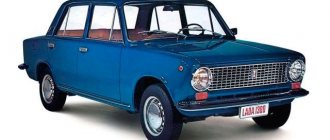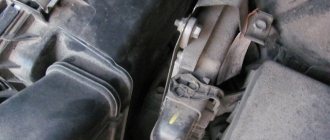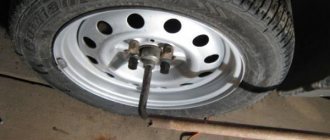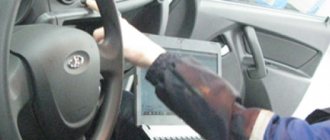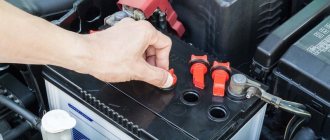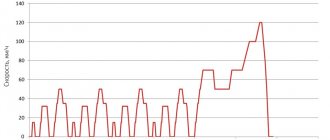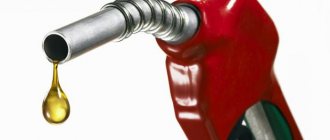Few people know that the VAZ 2104 (“four”) also bears the foreign name Lada Nova Break. This is a five-seater station wagon, which belongs to the second generation of AvtoVAZ “classics”.
The first models left the factory in September 1984 and thereby replaced the first generation station wagon - VAZ 2102. Although for another year (until 1985) the Volzhsky Automobile Plant produced both models simultaneously.
VAZ 2104 cars were created on the basis of the VAZ 2105, only they had significant differences:
- extended rear part;
- folding rear bench;
- increased gas tank up to 45 liters;
- rear wipers with washer.
It must be said that the “four” were actively exported to other countries. In total, 1,142,000 VAZ 2104 units were produced.
Along with the VAZ 2104, its modification was also produced - the VAZ 21043. This is a more powerful car with a 1.5 liter carburetor engine and a five-speed gearbox.
Video: review of the Quartet
Official data (l/100 km)
| Engine | Consumption (city) | Consumption (highway) | Flow (mixed) |
| 1.3 MT 64 hp (Mechanics) | 10.1 | 5.8 | 7.4 |
| 1.5 MT 75 hp (Mechanics) | 10.3 | 7.4 | 9.0 |
| 1.6 MT 74 hp (Mechanics) | 9.5 | 6.9 | 9.2 |
| 1.7 MT 79 hp (Mechanics) | 9.5 | 7.2 | 8.3 |
| 1.5 MT 50 hp diesel (mechanics) | 5.7 | 5.8 | 5.8 |
Table of fuel costs for VAZ brands.
The table describes the average costs for different VAZ brands . Fuel consumption is presented in three types - city, highway and mixed (average) fuel consumption. All data on fuel costs are from the VAZ car manufacturer. For almost all brands of VAZ cars, fuel consumption does not exceed 10 liters per 100 km, with the exception of the carburetor Niva.
Average fuel consumption VAZ
VAZ has acceptable fuel consumption!
The car is given good dynamics and acceptable fuel consumption thanks to its reliable engine. VAZ has an affordable price for both a new and an old car. Old VAZ brands are acceptable to most people. The new VAZ engine demonstrates extreme efficiency, thanks to which the car has low fuel consumption and a reduced level of harmful emissions into the atmosphere.
VAZ - average quality cars, affordable price and acceptable fuel consumption.
What could cause increased consumption at VAZ?
1. Increased VAZ fuel consumption is observed in cars with a worn out engine. High piston wear will increase fuel consumption of any VAZ brand. Wear is determined by measuring compression in the VAZ engine block. If the compression is low, the piston needs to be replaced (rings, piston, block boring).
2. The increased flow rate is influenced by the coolant temperature, throttle position, mass air flow and detonation sensors.
3. High fuel consumption in VAZ cars is observed when the accelerator drive is faulty, the wheel alignment is adjusted correctly, or tire pressure is reduced.
4. An increase in fuel consumption in VAZ cars with carburetor engines is observed when there is a problem with the carburetor. These are holes in the diaphragms, incorrect adjustment of the choke cable, enlarged fuel jets, mixing up of air jets in two working chambers (chamber 1 = 165 mm, chamber 2 = 125 mm).
Timely completion of technical inspection will allow VAZ to maintain fuel consumption at the level declared by the manufacturer.
How to reduce fuel consumption
In order not to constantly pour a large amount of fuel into the VAZ fuel tank, you should follow a few simple rules
:
- you should adhere to a more restrained driving style without sudden braking and sudden starts;
- in the cold season, leave your four in warmer rooms - this will help you spend less time warming up the engine and, accordingly, reduce fuel costs;
- use only high-quality fuel;
- Monitor the general condition of your car and promptly replace outdated or worn parts.
Such small tricks will help reduce the fuel consumption of the VAZ 2104 to a minimum.
Load capacity and capacity of VAZ station wagons and hatchbacks
Those who especially value a truck in a passenger car prefer station wagons, or, in extreme cases, hatchbacks.
- the most common and cheapest station wagon. The “Four” does not amaze with the high-pile carpets in the trunk (there are none there at all) and the exquisite door upholstery. But the plastic is easy to clean, it is not afraid of spilled Antifreeze and Obzor. Like a truck, the car is spoiled by the awkward trunk shelf, the fifth door opening tapering towards the bottom, and the wheel arches. You can easily transform the interior.
— the last word in the field of domestic universal construction. The successor to the Quartet holds 25% more in volume and 10% more in weight. In terms of carrying capacity, the “eleventh” was even ahead of the spring-loaded “Volga”. The rear seat, like on decent foreign cars, easily folds out in parts (2:1), creating the only problem - where to put the headrests? In general, the “eleventh” is a modern, surprisingly roomy “shed”. In terms of product and price: a front-wheel drive station wagon is twice (!) more expensive than a “classic” one.
If the “barn” is not to your liking, but you need to carry something more than a “diplomat”, they choose a compromise - a hatchback.
— at the beginning of production it was perceived as a prestigious, not a “business” car. Nowadays, when purchasing a Samara, its cargo qualities are increasingly taken into account. When the rear seat is folded down, the luggage compartment is quite spacious, but difficult to load. A natural disadvantage of all hatchbacks: the rear side and the fifth door get in the way. The volume of the cargo compartment is eaten up by the sloping rear wall - with comparable internal dimensions, the “nine” holds 50 liters less than the “four”. The three-door VAZ-2108 will cause even more inconvenience - it can only be loaded through the rear door, while the 2109 allows you to use a pair of side doors. “Nine” is the most modest hatchback in terms of cubic capacity. In this car, the passenger element still dominates. Cargo capabilities are more of an add-on to other qualities.
Characteristics of VAZ station wagons and hatchbacks
| in standard version | 270 | 380 | 255 |
| when loaded to the ceiling | 470 | 575 | 355 |
| With the rear seat folded | 970 | 1215 | 920 |
| Dimensions, mm | |||
| A – total length of the luggage compartment | 1600 | 1630 | 1380 |
| B – distance to the rear seat | 1000 | 1030 | 820 |
| B – width of the compartment between the wheel arches | 910 | 930 | 930 |
| G – height | 800 | 930 | 850 |
| D – tailgate height in hatchbacks | 320 | ||
| E – rear door opening height | 730 | 890 | 490 |
| Weight, kg: | |||
| Curb Cargo transported | 1020 455 | 1030 500 | 945 425 |
Based on materials from the magazine “Behind the Wheel” No. 1, January 2000.
Official data (l/100 km)
| Engine | Consumption (city) | Consumption (highway) | Flow (mixed) |
| 1.3 MT 64 hp (Mechanics) | 10.1 | 5.8 | 7.4 |
| 1.5 MT 75 hp (Mechanics) | 10.3 | 7.4 | 9.0 |
| 1.6 MT 74 hp (Mechanics) | 9.5 | 6.9 | 9.2 |
| 1.7 MT 79 hp (Mechanics) | 9.5 | 7.2 | 8.3 |
| 1.5 MT 50 hp diesel (mechanics) | 5.7 | 5.8 | 5.8 |
VAZ-2104 engine and its features
Engine 2104-1000260
can be used for installation on VAZ 2103, 2104, 2106, 21053, 2107 cars. Initially, the VAZ 2104 engine was produced only in a carburetor version. Subsequently, it was modified to use a fuel injection system and received the designation VAZ 2104-21. The VAZ 2104 engine was created on the basis of the previous model - VAZ 2103. The design used: a cylinder block, a connecting rod and piston group, a timing drive and a crankshaft from the 2103 engine.
photo VAZ-2104 engine
Cylinder block from a VAZ 2103 engine. Cylinder diameter - 76.00 mm. The accepted overhaul dimensions are 76.40 and 76.80. The engine is equipped with a crankshaft 2103 or an interchangeable shaft model 21213. To ensure the operation of the injection system, it was necessary to install components and parts from other engines that were originally developed for an injection fuel supply system. A new camshaft drive cover is used, on which there is space for installing a sensor that controls the position of the crankshaft. It was necessary to install cylinder head 2104-1003015, an original design, with enlarged areas for the intake manifold. The design of the head provides for the installation of nozzles. The camshaft, valves and springs correspond to those installed on the VAZ 2103 engine. The installation of hydraulic supports for the valve levers is not provided. The timing drive is carried out from a double-row bush-roller chain 2103-1006040. The chain tensioning mechanism is mechanical, similar to the device on the VAZ 2103 engine.
A pulley with a damper and a drive disk 21214-1005058-11 is installed on the crankshaft. To drive the generator, a belt 2107-1308020 is used (length - 944 mm). The injection modification 2104 has an original power system. The system includes an electric fuel pump with a fuel level indicator sensor, fuel lines, a fuel filter, a fuel rail with injectors, an air filter, air supply hoses, a throttle valve and a fuel vapor recovery system. To clean the air entering the engine, an air filter model 2112 is installed. A receiver model 2104 or model 2123-1008027 is installed together with the intake manifold. To adjust the volume of incoming air, a throttle pipe 2112 is installed. The electric fuel pump module 21073-1139009 is installed in the tank and supplies fuel to the fuel rail and injectors. The original fuel rail 2104-1144010 is used, box type with pressure regulator and return drain pipe. Injection is carried out using four nozzles of pair-parallel action. It is possible to install nozzles BOSCH 0 280 158 502 (black, thin), SIEMENS VAZ 6393 (beige, thick) or other types with the appropriate parameters. The ignition system includes: a Model 2112 ignition module mounted on a special bracket on the cylinder block, spark plugs and high voltage wires. The ignition module includes two ignition coils and two electronic control devices. In accordance with control signals from the control unit, the ignition module generates and supplies high-voltage pulses to the spark plugs. Ignition control is assigned to the electronic engine management system. This system controls the amount of air and fuel supplied to the cylinders, controls the operation of the fuel pump, controls the supply of high-voltage pulses from the ignition coil to the spark plugs and adjusts the ignition timing, regulates the crankshaft speed at idle. The main control element of the system is the electronic control unit (ECU)-controller. The engine complies with EURO-2 toxicity standards.
The VAZ 2104 model was produced until 2012, and in recent years the car was produced in Izhevsk. She received many modifications. Cars of recent years of production were equipped with a radiator grille from the VAZ 2107.
Review of the VAZ 2104 model
The Volzhsky Automobile Plant produced many classic and working models for private use. And if production began with sedans, then the first station wagon was the “four”. The new body and new capabilities of the model immediately attracted the attention of buyers.
Model review: VAZ 2104 without embellishment
Few people know that the VAZ 2104 (“four”) also bears the foreign name Lada Nova Break. This is a five-seater station wagon, which belongs to the second generation of AvtoVAZ “classics”.
The first models left the factory in September 1984 and thereby replaced the first generation station wagon - VAZ 2102. Although for another year (until 1985) the Volzhsky Automobile Plant produced both models simultaneously.
VAZ 2104 cars were created on the basis of the VAZ 2105, only they had significant differences:
- extended rear part;
- folding rear bench;
- increased gas tank up to 45 liters;
- rear wipers with washer.
It must be said that the “four” were actively exported to other countries. In total, 1,142,000 VAZ 2104 units were produced.
Along with the VAZ 2104, its modification was also produced - the VAZ 21043. This is a more powerful car with a 1.5 liter carburetor engine and a five-speed gearbox.
Video: review of the Quartet
Specifications
A car in a station wagon weighs a little, only 1020 kg (for comparison: the “five” and “six” in a sedan body weigh more - from 1025 kg). The dimensions of the VAZ 2104, regardless of the configuration, are always the same:
- length - 4115 mm;
- width - 1620 mm;
- height - 1443 mm.
Thanks to the folding rear row, the trunk volume can be increased from 375 to 1340 liters, which made it possible to use the car for private transportation, country work and even small businesses. However, the back of the rear sofa does not fold entirely (due to the specific design of the car), so it is impossible to transport long cargo.
However, long elements are easy to fix on the roof of the car, since the length of the VAZ 2104 allows you to transport beams, skis, boards and other long items without the risk of creating dangerous road situations. But you cannot overload the roof of the car, since the calculated rigidity of the station wagon body is much lower than that of sedans of the next generations of VAZ.
The total load on the vehicle (passengers + cargo) should not exceed 455 kg, otherwise damage to the chassis may occur.
The “Four” was equipped with two types of drives:
- FR (rear-wheel drive) is the basic equipment of the VAZ 2104. Allows you to make the car more powerful.
- FF (front-wheel drive) - selected models were equipped with front-wheel drive, as it is considered safer; subsequent versions of the VAZ began to be produced only in front-wheel drive.
Like other Lada representatives, the Four has a ground clearance of 170 mm. Even today, this is a completely reasonable ground clearance, allowing you to overcome major road obstacles.
Engine characteristics
Over the years, the VAZ 2104 was equipped with power units of different power: from 53 to 74 horsepower (1.3, 1.5, 1.6 and 1.8 liters). Two modifications (21048D and 21045D) used diesel fuel, but all other versions of the “four” consumed AI-92 gasoline.
Depending on the engine power, fuel consumption also varies.
Table: average fuel consumption per 100 km
| Options | Fuel consumption, l/100 km | Fuel used |
| 1.8MT 21048D | 5,5 | Diesel fuel |
| 1.5MT 21045D | 8,6 | Diesel fuel |
| 1.6MT 21041 | 8,8 | Gasoline AI-92 |
| 1.3MT 2104 | 10,0 | Gasoline AI-92 |
| 1.5MT 21043i | 10,3 | Gasoline AI-92 |
| 1.5MT 21043 | 10,3 | Gasoline AI-92 |
The VAZ 2104 accelerates to a speed of 100 km/h in 17 seconds (this is a standard indicator for all VAZs produced in the 1980–1990s). The maximum speed of the machine (according to the operating instructions) is 137 km/h.
Table: parameters of the “four” motor
| Number of cylinders: | 4 |
| Cylinder displacement, l: | 1,45 |
| Compression ratio: | 8,5 |
| Rated engine power at a crankshaft speed of 5000 rpm: | 50.0 kW.- (68.0 hp) |
| Cylinder diameter, mm: | 76 |
| Piston stroke, mm: | 80 |
| Number of valves: | 8 |
| Minimum crankshaft speed, rpm: | 820–880 |
| Maximum torque at 4100 rpm, N*m: | 112 |
| Cylinder operating order: | 1–3-4–2 |
| Octane number of gasoline: | 95 (unleaded) |
| Fuel supply system: | Electronically controlled distributed injection |
| Spark plug: | А17ДВРМ, LR15YC-1 |
Questionable ways to adjust fuel consumption
Questionable methods for reducing gasoline consumption on both carburetor and injection engines include installing fuel activators on hoses or adding additives to the tank. Magnetic treatment of the hydrocarbon flow does not affect the processes of formation of the working mixture and combustion, so the installation of activators does not bring results. The owner may note a change in consumption of 0.1-0.3 liters, which is a statistical error and is associated with unstable quality of gasoline or a change in the road situation.
Adjusting the carburetor to excessively lean the working mixture and reducing idle speed leads to unstable operation of the engine, which stalls when the speed is reduced. Some owners, when driving downhill, move the gearbox lever to the neutral position. If the engine stops, the brake booster stops working. On a long descent, you must leave the gear engaged and release the accelerator pedal (switch to engine braking mode). Cutting off the fuel supply improves efficiency.
The use of additives negatively affects engine parts on which carbon deposits form, causing glow ignition and disrupting the normal operation of the engine. Until the beginning of the 90s. last century, due to a shortage of AI-93 gasoline, it was practiced to convert engines to fuel with a lower octane number (for example, A-76 was widely used to refuel trucks). The modification consisted of installing a thicker head gasket and adjusting the ignition timing, but it negatively affected the power and service life of the VAZ-2107 engine.
Gasoline consumption data for the VAZ 2104. Tips for reducing fuel consumption
The VAZ 2104 car was developed by Soviet engineers for the broadest masses of the population, the main tasks that were set for the developers were the ease of assembly and repair of the car, as well as the maximum cost reduction in its manufacture and maintenance. They began producing cars back in 1984, their production continued until 2012, during which time the engine was modernized several times, the body concept remained unchanged, this is a station wagon with five doors, with a spacious luggage compartment. As for the fuel consumption of the VAZ 2104, depending on the engine size, its design and the quality of the road, the car consumes from 6 to 10 liters of gasoline or about 6 liters of diesel fuel.
Manufacturer data
| Engine, modification | Fuel consumption in the urban cycle, l/100km | Fuel consumption in the extra-urban cycle, l/100km | Fuel consumption in the combined cycle, l/100km |
| VAZ 2107 (engine 2103, 1.5 l, carburetor, 72 hp) | 9,6 | 7,4 | 8,5 |
| VAZ 21072 (engine 2105, 1.3 l, carburetor, 64 hp) | 9,4 | 6,9 | — |
| VAZ 21073 export version (1.7 l, single injection) | 8,9 | 5,3 | 6,4 |
| VAZ 21074 (engine 2106, 1.6 l, carburetor, 75 hp) | 9,8 | 7,1 | 8,5 |
| VAZ 21074–20 (1.6 l, injector, EURO‑2) | 9,7 | 6,8 | 8,5 |
| VAZ 21074–30 (1.6 l, injector, EURO‑3, 74 hp) | 9,7 | 6,8 | 8,5 |
VAZ 2105 in detail about fuel consumption
In today's article we will talk about the cars of the Volzhsky Automobile Plant. Despite the emergence of new car models, experienced drivers still prefer to choose an “iron horse” based on its consumer ability: real and declared.
For example, the declared fuel consumption of the VAZ 21053 per 100 km is 9.1 liters. But in fact, fuel consumption on the Lada 21053 when traveling in the city is on average 8.1 liters, and outside the city - 10.2 liters.
Moreover, these are average figures that correspond to approximate mileage with engines of the same power. It is for their reliability and affordable price that Lada cars are loved.
Leakage problem: what threatens it and how to determine it
Many novice drivers wonder: why is so much attention paid to fuel consumption? If you have a carburetor, then increased fuel consumption not only hurts your pocket, but also indicates malfunctions and (or) improper care of the car. That is, if the standard fuel consumption for a 2105 in the city is no more than 10.5 liters, but it takes you 15, it’s worth thinking about. Perhaps there is a leak somewhere? You can view the standards in the technical specifications for your car.
If your car was purchased not in the 80s of the twentieth century, but later, then you have a solex type carburetor, which has little in common with the “ozones” with which the “career” of the Volzhsky plant began. These two types of carburetors differ only in the control system, but in essence their operation is one and the same.
What can determine the amount of fuel spent?
- Real gasoline consumption of a VAZ 2105 in the highway cycle with an engine power of 64 hp. is 9.5 liters at a speed of 120 km/h and 6.8 liters if the speed is up to 90 km/h. When driving around the city - 10.2 liters. The difference is the four-speed gearbox.
- Average gasoline consumption for a VAZ 2105 with a five-speed gearbox and an engine of 71.1 hp. on average 0.2 liters lower.
Is it possible to develop individual standards?
Whether or not to use the standards of the Ministry of Transport in your work is the decision of the company’s management. That is, at the legislative level there are no requirements for the mandatory use of NRT.
The Tax Code does not require standardization of costs for fuels and lubricants either according to the corporate income tax or under the simplified tax system. A similar position is supported by the Ministry of Finance (Letters dated March 22, 2019 No. 03-03-07/19283, dated September 27, 2018 No. 03-11-11/69335). Each organization must make its own decision about working with fuel standards.
Cost standards are allowed to be developed independently. For example, an institution, based on the recommendation of the Ministry of Transport, approves its own standards. The indicators correspond to the real characteristics of vehicles used in the process of life.
The ministry's recommendations are just standard values calculated based on the general characteristics of car brands. Despite the correction factors, in practice the values differ significantly from the actual costs. Therefore, organizations have the right to approve their own indicators.
Approve standard values by local order.
What affects consumption?
Next, we will look at what can affect and how to reduce fuel consumption on the VAZ-2106. Here we note that it will not be possible to reduce consumption below certain indicators, since the engine will not operate in air, but minimizing consumption as much as possible is quite possible. Here we will also not consider miracle devices and additives that supposedly can significantly help in this matter and reduce gasoline consumption by almost half. All this is nothing more than another way to lure money from the car owner, but there is no real benefit from it.
VAZ-2106 has high fuel consumption, then you can take some steps that can really have a positive effect on gasoline consumption.
The main criteria that affect consumption are:
- Technical condition of the car;
- Features of operation;
How does this system work?
In order to correctly determine in the future why you are using a lot of fuel, you need to know how the engine power system works. With this knowledge, you will already know how to reduce the fuel consumption of your UAZ.
After air enters the intake manifold, the volume will be measured by a certain sensor. All this information will then go to the ECU. The process will receive the task of injecting fuel through an injector, or, to be precise, through injectors. Everything that is released into the atmosphere is detected by the exhaust measurement sensor. The data obtained helps determine the actual fuel consumption.
Already with knowledge about the operation of the entire system, it is easier to find the exact reason for the unreasonably high consumption of gasoline.
Fuel consumption, increased consumption - what is the reason? How to reduce?
#1 Dusk
- Users
- 19 messages
- Top
Actually the subject. What determines fuel consumption and how can this consumption be reduced? Who has proven or not so proven methods? let's share?
What about additives, various fuel additives or some additional equipment? Who tried what?
#2 Je-dai
- Top
#3 dell
Human passions are boiling around, Everyone is not happy with fate: Some need a crown of power, Others need wealth and success. And I live like a free wind, That strokes the blue sky And without a lucky ticket - I am happy that I live!
- Top
#4 Yuri
So, let’s analyze what determines fuel consumption and how to reduce it?
1. What (what kind of crap) did you fill at the gas station and how much they cheated you, i.e. how much of this slurry called zebin was underfilled 2. How big is your car (1 ton of iron, rubber and plastic, or 2, or even three - there are those too) 3. How well the engine of your bucket with nuts works 4. How often and sharply you press the gas pedal/brake pedal.
So, the first point is completely beyond your control, the second and third you can influence to a limited extent, mainly when buying a car, and the fourth is completely in your control. If you don’t press the gas/brake pedals at all, then the consumption may become zero! ))) Use my wisdom while I'm alive!
- Top
#5 SUROK
. just like an umbrella for a fish
Current Yulmart Promo Code 1356869 Buy not at the retail price, but at the 2nd column of the price list! Click and register on the page that opens.
- Top
#6 Vadik
By the way, the issue of fuel consumption is especially interesting to me. All sorts of additives, etc. This is the ravings of a madman in my opinion, I think many will agree with me. Various additives can only cause time to your engine and fuel system. According to the vehicle's technical passport, the average fuel consumption is indicated. You can reduce it by refueling with high-quality gasoline and driving the car smoothly, without such things as slipping, over-throttle, etc.
But if the car consumes more fuel than it should according to its passport, this is a problem. What should I do? Or more precisely, what is the reason? Where to look?
The car is a VAZ 21041-30 (four). Injector. I measured it not with the on-board computer, but with the fuel level light in the fuel tank. I fill up with 12 liters of gasoline - enough for exactly 100 km. And so 20 times, or even more. This is around the city. On the highway, with the calmest and most economical driving style, 10 liters still come out. That's a LOT. On the highway, 7-8 liters per hundred would be just right.
The question is - what to do? It is clear that the first thing you need to do is check the injector (the brains of the car), if there are any problems, the computer will remember them and show them, BUT. Firstly, they already checked it - and nothing abnormal was shown. All indicators are normal. Secondly, considering that this is still a Russian auto industry, I somehow don’t really trust its computer. But maybe it’s not the brains at all, but the hardware. What affects consumption in the car itself? (valve or something else.)
When throwing garbage on the shore, don’t forget to grunt.
- Top
#7 SUROK
— you also need to take into account the mileage of the VAZ — the type of injector, sometimes it’s a device like an electronic carburetor without feedback — the type of firmware, there are a lot of options and modifications. If you want power, if you want savings, you need to take into account both the mileage of the VAZ and the maintenance of the car.
. The manufacturer provides ideal conditions, they do not exist. Let's remember the operating time of a laptop or phone. smiled?
Current Yulmart Promo Code 1356869 Buy not at the retail price, but at the 2nd column of the price list! Click and register on the page that opens.
- Top
#8 Vadik
SUROK (November 18, 2012 - 14:20) wrote:
- you need to take into account the mileage of the VAZ - the type of injector, sometimes it is a device like an electronic carburetor without feedback - the type of firmware, there are a lot of options and modifications. you want power, you want savings
. The manufacturer provides ideal conditions, they do not exist. Let's remember the operating time of a laptop or phone. smiled?
Not an argument. 1. The car is 4 years old, I bought it new, the mileage in 4 years is only 35,000 km. 2. What does injector type mean? It’s a computer and a computer in Africa, and a licensed one. This is not an abacus. 3. It makes sense to do the firmware if you want to increase the engine power, and accordingly the consumption will increase. And reducing consumption due to firmware is not an option, because the car may not move at all. First you need to find out why the consumption has increased, i.e. not normal.
Well, idk. how about ideal conditions. A friend's Logan eats 5-5.5 liters on the highway. Well, to hell with the VAZ - 7-8 liters, but not 10.
When throwing garbage on the shore, don’t forget to grunt.
- Top
#9 SUROK
Vadik (November 18, 2012 - 14:36) wrote:
On the vases they put: - General Motors; — January 4, 4.1, January 5, 5.1, 5.1.1, 7.2, etc.; - Bosch 1.5.4, 1.5.4.N, MP7.0, MP7.9.7; — VS (Itelma). . What do you have ? General Motors is a thing, January is crap. the rest is something average - these are fundamentally different brains.
There is no need to confuse the basin and the logan (especially the logan of the first issues and the basin of the latest). what else can it do, almost everything, there are many options, from valves to chassis (camber, compression, valve adjustment, etc., for example, trunk arches at a good speed of +1l).
Post edited by SUROK: November 18, 2012 - 17:10
Current Yulmart Promo Code 1356869 Buy not at the retail price, but at the 2nd column of the price list! Click and register on the page that opens.
- Top
#10 Vadik
SUROK (November 18, 2012 - 17:04) wrote:
When throwing garbage on the shore, do not forget to grunt.
- Top
#11 SUROK
Current Yulmart Promo Code 1356869 Buy not at the retail price, but at the 2nd column of the price list! Click and register on the page that opens.
- Top
#12 Vadik
When throwing garbage on the shore, don’t forget to grunt.
- Top
#13 Yuri
Vadik (November 18, 2012 - 19:37) wrote:
- Top
What is the fuel consumption per 100 km of VAZ-2104
In Soviet times, car owners were not particularly concerned about the gluttony of their cars - except that the consumption indicators clearly exceeded the norm. Gasoline was quite cheap, so pouring another portion into the tank had virtually no effect on the family budget. Today the situation has changed, and for the worse. Accordingly, fuel consumption is currently one of the priorities, for example, when purchasing a new iron horse. At the same time, older car owners carefully monitor that fuel consumption does not exceed the norm. This fully applies to the VAZ “classics”. Many representatives of this family today can safely be called venerable old men (by automotive standards). Long service life in combination with design solutions of the 70-80s of the last century lead to the fact that the car becomes quite voracious. Accordingly, VAZ owners strive, if possible, to reduce this indicator. Practice has shown that it is quite possible to do this - the main thing is to know how.
VAZ-2104 – what fuel consumption per 100 kilometers is considered normal
Naturally, speaking about the Quartet’s appetite, specific figures should be given. First of all, it is worth recalling that this model was supplied to the market with different types of engines. Of course, their fuel consumption indicators are different. Generally speaking, during the period when the Quartet was produced, 3 types of engines were installed on it:
- carburetor;
- injection;
- diesel.
However, the latter never became widespread. The cost of a car with a diesel engine was higher than with a gasoline engine, while in terms of power it was slightly, but still inferior to both carburetor and injection engines. As a result, not many of these cars came off the assembly line. The VAZ-2104 was equipped with a 4-cylinder, 8-valve, one and a half liter diesel engine. The power of this power plant is 50 horsepower. Motors of this type are characterized by low fuel consumption. The diesel engine installed on the VAZ-2104 was no exception to the rule.
The consumption figures pleased the owners - 6.7 and 5.8 liters in the city and on the highway, respectively. However, high initial costs have scared off many potential buyers.
Engines with carburetors have higher consumption rates, of course. The “fours” were equipped with 2 types of such power plants. The first is the VAZ-2103, 4-cylinder, 8-valve, 1.3 liter. The power of this engine is 63 horsepower. When driving on a city highway, this engine consumes 10 liters per hundred. On the highway, consumption is 6.9 liters.
Another carburetor engine installed on the “four” was the one and a half liter VAZ-2103 power plant. The 4-cylinder 8-valve engine in the city and on the highway consumed, respectively, 9.8 and 7 liters per 100 kilometers.
And finally, injection engines. Two models of such power plants were installed on the Quartet. One of them is VAZ-21073. A special feature of this 1.7-liter 4-cylinder, 8-valve engine is central fuel injection. With a power of 84 horsepower, this power plant consumed 9.5 liters in the city and 7.5 on the highway. However, there are different data on the latter indicator.
The VAZ-21067 engine with a volume of 1.6 liters was also installed on the Quartet. The 4-cylinder, 8-valve power unit with an output of 82 horsepower is quite voracious. In particular, in the city this modification consumes 11.3 liters. Agree, at current fuel prices it’s difficult to call such a car economical. When driving on a country highway, fuel consumption drops to 6.9 liters.
In conclusion, I would like to note one important point. Fuel consumption depends on many factors. Of course, the technical condition of the car plays an important role here. There are many breakdowns with which you can drive for a while, while the car’s appetite increases significantly. In order not to throw money away, you need to eliminate them as soon as possible. In addition, consumption directly depends on driving style. Sharp acceleration combined with active braking increases the vehicle's fuel consumption.
If you want to save money, then you need to give up this driving style. The driving style should be calm, with smooth acceleration and a minimum amount of braking, so that you do not have to pick up speed again. Otherwise, consumption on the “four” is unlikely to be less than 12 liters in the city.
Another important point is the time of year. Probably everyone knows that fuel consumption is higher in winter than in summer. Firstly, before driving off at sub-zero temperatures, it is recommended to warm up the car - and this means additional fuel consumption. Secondly, difficult weather conditions and slippery road surfaces force you to drive in lower gears, which, in turn, increases consumption.
